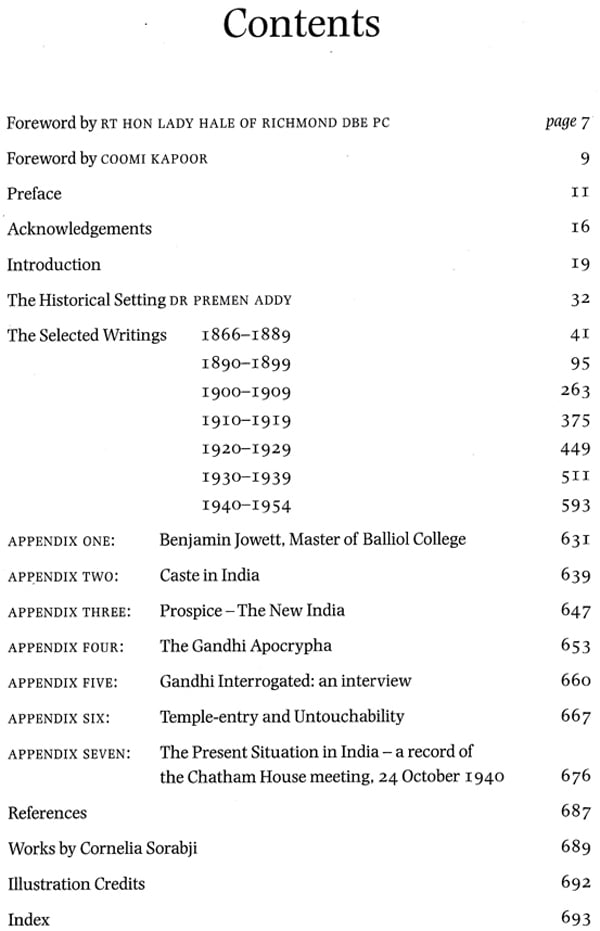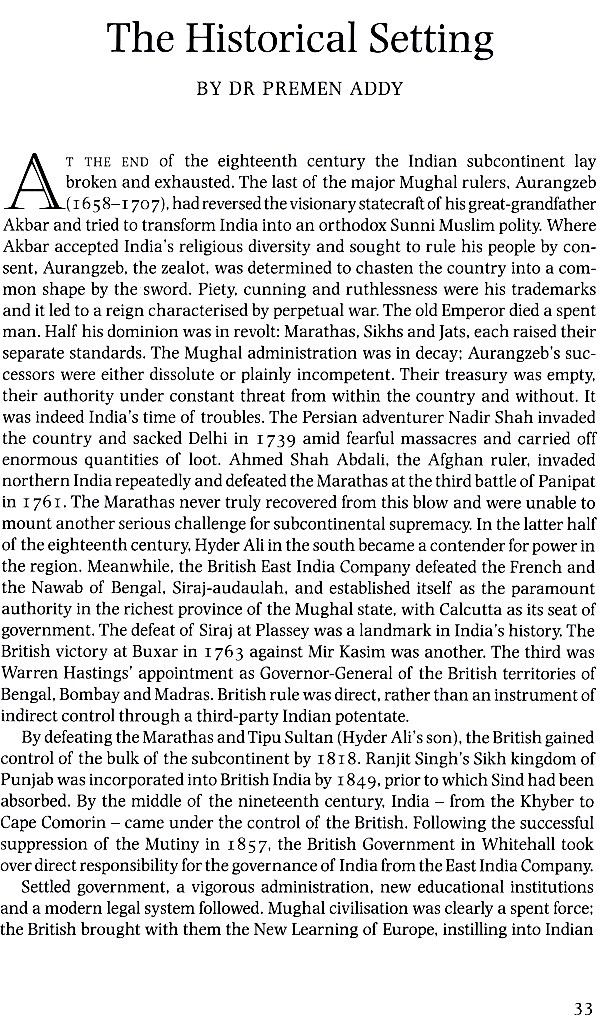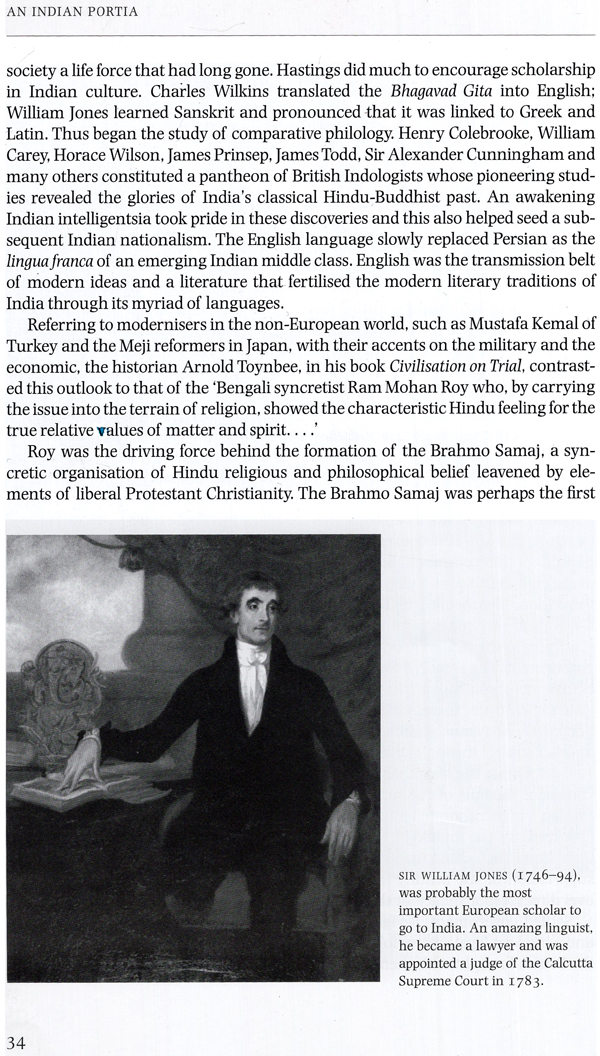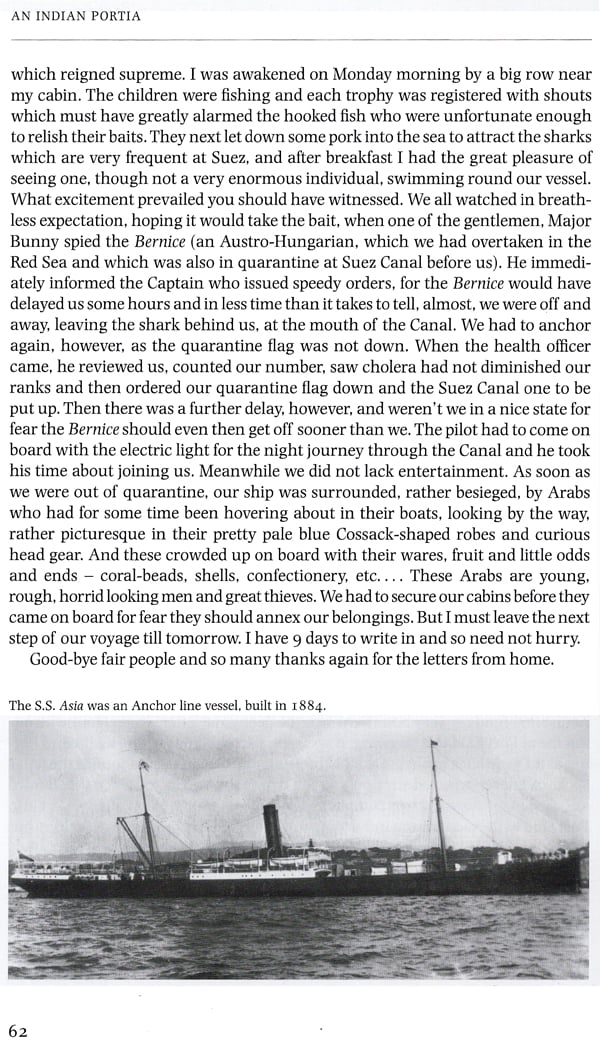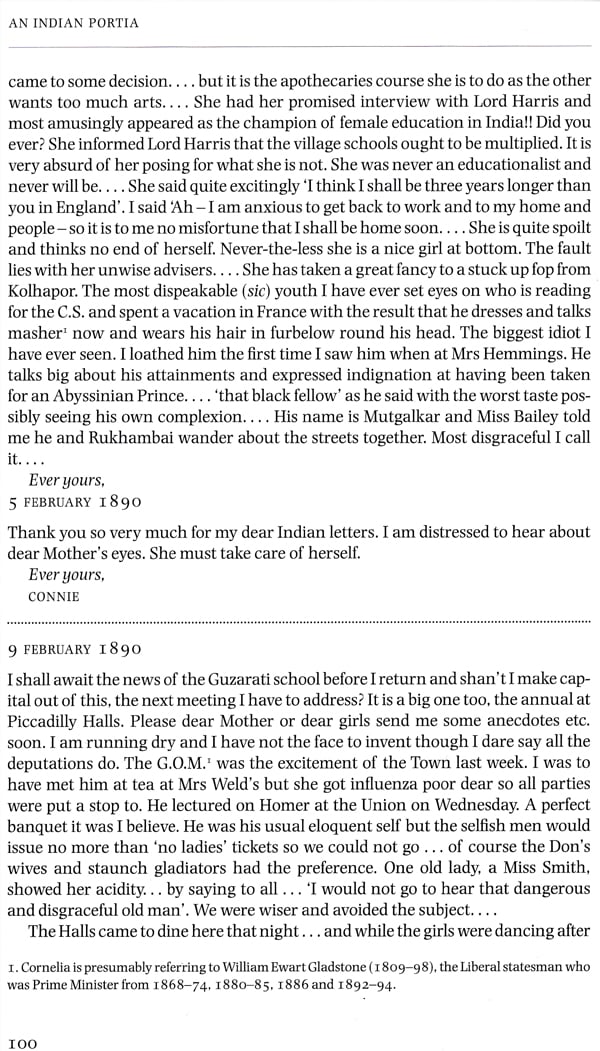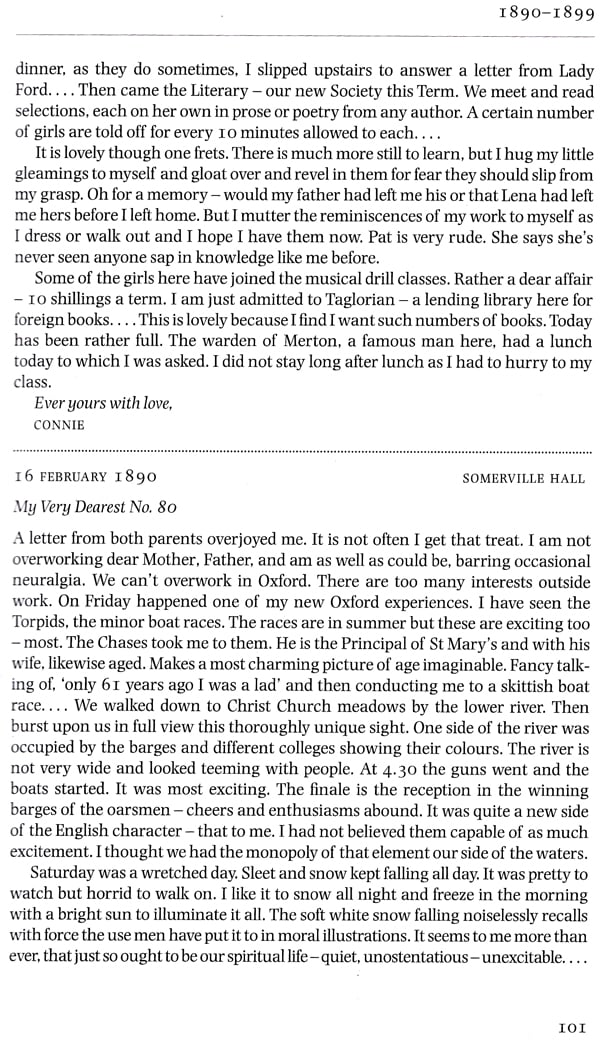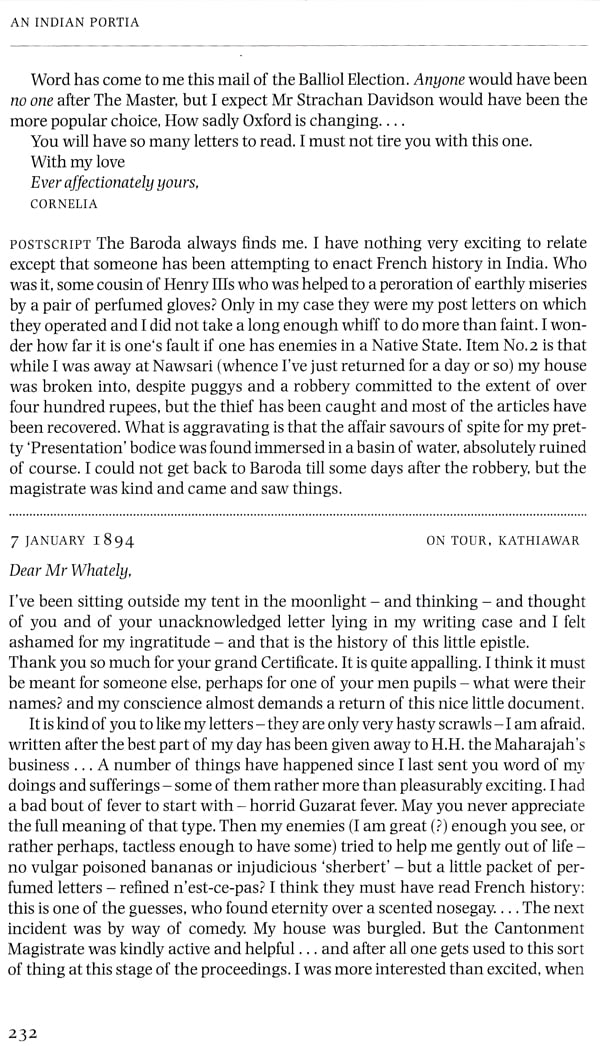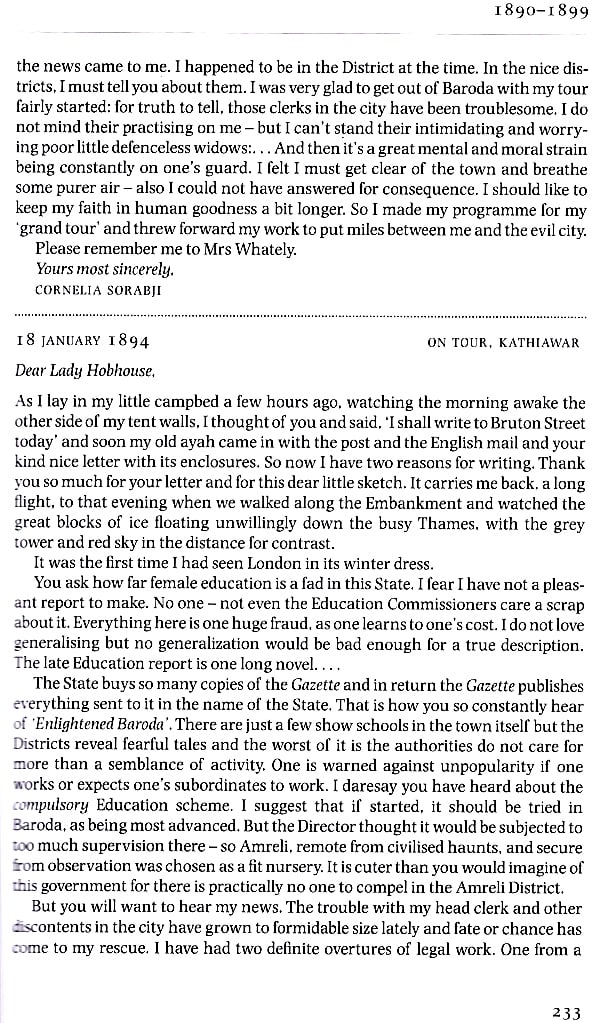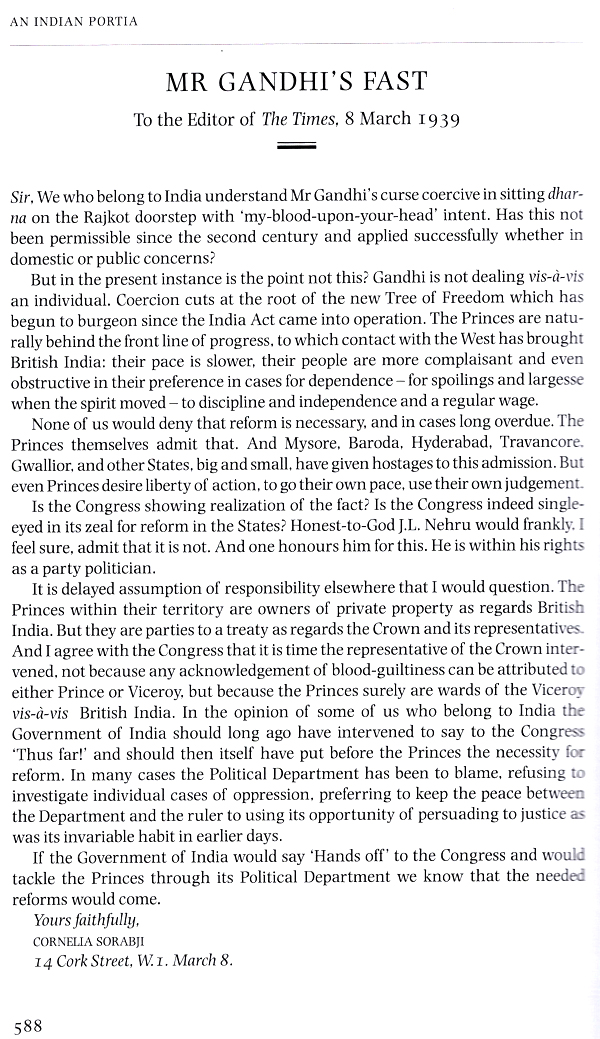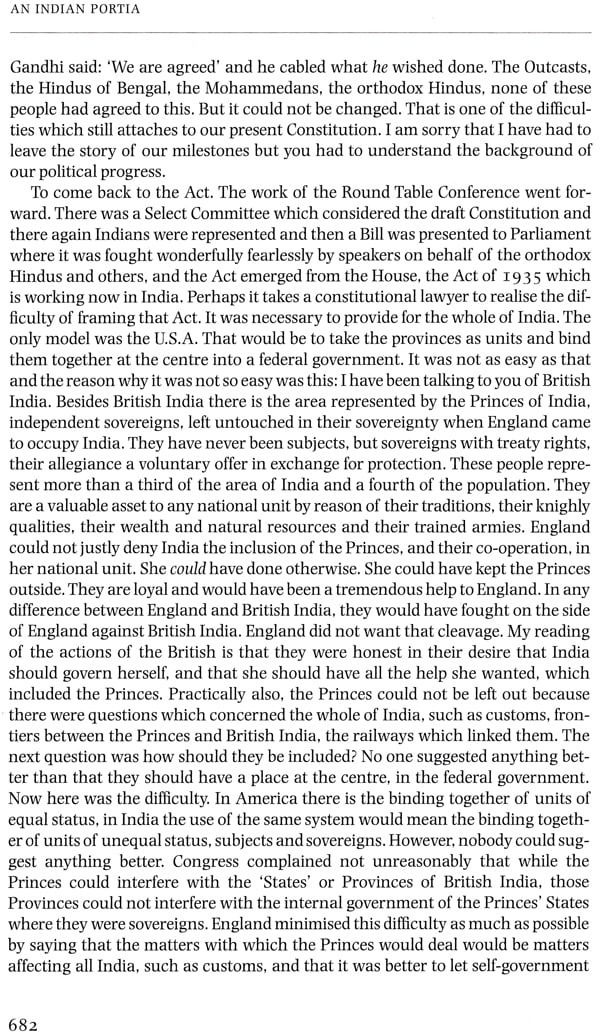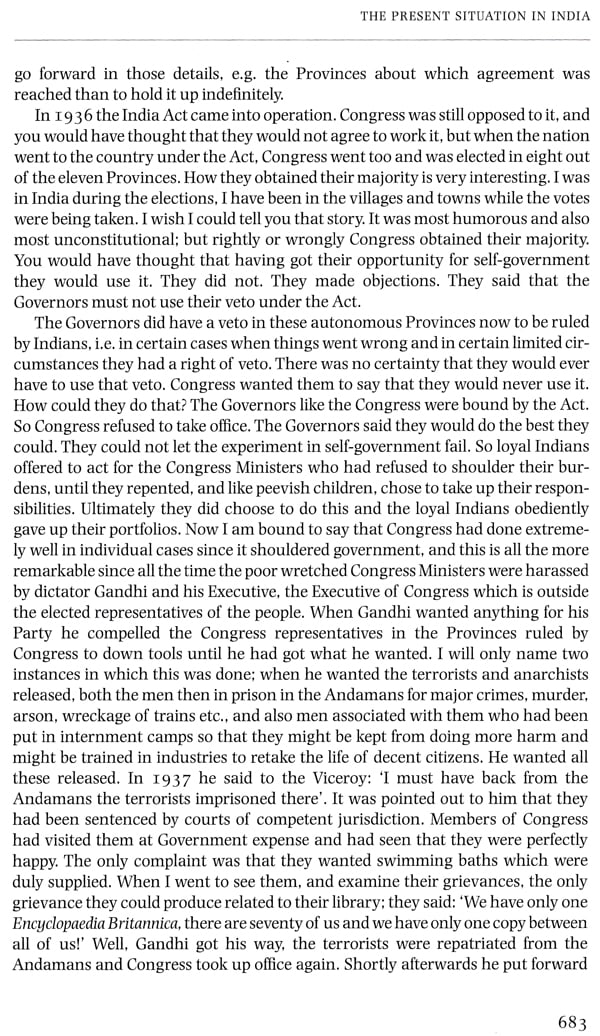
An India Portia (Selected Writings of Cornelia Sorabji 1866 to 1954)
Book Specification
| Item Code: | NAS340 |
| Author: | Kusoom Vadgama |
| Publisher: | Zubaan Publications |
| Language: | English |
| Edition: | 2011 |
| ISBN: | 9788189884765 |
| Pages: | 702 (Throughout B/W Illustrations) |
| Cover: | HARDCOVER |
| Other Details | 9.50 X 7.00 inch |
| Weight | 1.60 kg |
Book Description
As an eight-year-old child Cornelia sorabji witnessed the anguish of a Gujerati Hindu widow who had been swindled out of her very substantial inheritance by her trustee. Illiterate and only able to deal with the world outside the purdah through her sole trustee, she was typical of many purdahnishins who lost all their property. At that early age Cornelia resolved to become a lawyer; as a woman she would be able to overcome the restrictions of the purdah.
But the profession was not open to women at that time and it took a remarkable woman to flight to improve the education and rihts of Indian women. Cornelia was the first women (Indian or British) to sit the examination for the degree of bachelor of civil law (BCL) , at Somerville College, Oxford in 1892. It took another 31 years before she could be the English bar. In the meantime she worked tirelessly for the rights of purdahnishins an orphans’; in 1904 she was recognized by the Government as the lady legal adviser to the Court of Wards. She also supported traditional Indian life and culture, but campaigned to reform the laws on child marriage and the position of windows.
Cornelia practised in the Calcutta High Court from 1924 to 1929, when she moved to London. That same year she visited the United States and lectured at the Institute of Politics in Williamstown on the British rule of India. Until her Death in 1954 she spent most of her time in Britain but travelled extensively, going to India only in the winters. This fascinating book, in addition to encapturing Cornelia’s busy life, includes as lady Hale says in her Foreword, a ‘lovingly compiled selection from her voluminous writings [which] should also contribute to the mutual understanding between our peoples’. The writings include the fascinating report of her interview with Gandhi, when they agreed to treat each other as professionals (they were both barristers) and speak their minds ‘without fear of offence being given or taken’.
Cornelia Sorabji was a social reformer, an author and the first woman to practise law in India and Britain. By the time poor sight ended her work in India she had helped many hundreds of wives, widows and orphans. She also successfully organized a League for Infant Welfare. Maternity and District Nursing.
Her writing provide a priceless and fascinating documentation of one of India’s most outstanding women in nineteenth and twentieth century India and Britain. Her noble career and valuable archives have left behind a heritage to the people of India and their causes. Her really extraordinary life of dedication to public service, evident from her writings and ceaseless hard work, deserve to be acknowledged and publicised. This book achieves both.
KUSOOM VADGAMA, Doctor of Optometry, was born in Nairobi, Kenya, and educated at the Government Indian Girls' High School. She studied the glory and history of the British Empire at school but her time outside was spent leading anti-British rallies at the height of the 'Free India' and 'Quit India' movements. In 19 5 3 she came to Britain for further education and later went to Chicago for more studies. She also lived and worked in New York where she attended the American Academy of Dramatic Arts.
In London she studied at the London Academy of Music and Dramatic Arts. One of her great interests has been the special relationship that exists between India and Britain. While researching her first book India in Britain — which had Forewords by Mrs Indira Gandhi and Prince Charles — she discovered the 2 33 volumes of Cornelia Sorabji's private papers in the British Library. As she says in her Preface: 'I read the letters and diaries with great interest and excitement. It is not possible to read them without feeling intense admiration for her [Cornelia's] natural talent, perseverance and determination to fight for justice'. This book is the result of years of research into the extraordinary life of Cornelia Sorabji.
Kusoom practises in London, very much an Indian but totally committed to the British way of life — the British sense of humour being the linking factor. 'Britain is my home but India is my homeland' is how she describes her loyalty and love for the two countries. She was on the editorial board of India Weekly and chaired the committee to set up a Centre for Research in Asian Migration at the University of Warwick. She is a trustee of the ASHA Centre —an international centre working for peace and understanding.
During the raj many Britons on governmental appointments in India saw the importance of putting on paper their observations of the country and its peoples, either for posterity or for pleasurable recollection. Some drew inspiration from the beauty of the country, as did Sir James Piele (1833-1906) who made a series of sketches in ink during his travels in India. Other, especially the memsahibs, kept diaries or wrote detailed and descriptive letters to their friends and families in England which were often published. These records of life in India, written and illustrated in amazing detail, are tapestries of Indo-British history. The British not only ruled India but made sure, through careful documentation, to put their presence in India on record. Their hold on history was admirable: every detail of their work and play in India was described.
Lesser known are the autobiographical impressions of Indians who came to Britain during the years of the East India Company and the Raj. Many kept records of their daily activities and experiences in England. Their published diaries and memoirs give vivid accounts of the British social. Political, academic and cultural lives, as well as the curiosity with which every aspect of their own life was observed wherever they travelled in the country. The existence of these valuable chronicles of the life and times of Indians in Britain are unknown outside the walls of reference libraries and the names of their authors, let alone their contributions, remain unremembered and unacknowledged. These out-of-sight and out –of-mind archives are historical records of the unique relationship between the Indians and the British outside colonised India. The ‘natives’ of India were celebrities in Britain. The colour of their skin, the clothes they wore and the way they spoke fascinated the ‘natives’ of Britain. There was none of the arrogance of the British in India. Visiting Indians were deeply touched by the kindness and warmth of hospitality shown to them.
The earlier record of travels to the West by an Indian is that written by Mizra Sheikh I’tesamuddin, employed by the East India Company, who came to England in 1765. He had been on a mission to seek protection for the Moghul Emperor Shah Alam II. Scholarly and culturally refined, Mizra gives a fascinating account of his observations of social, political and educational life in England and Scotland in the observations of social, political and educational life in England and Scotland in the reign of George III, describing how he himself became a spectacle wherever he went. He visited Westminster Abbey and St Paul’s Cathedral and describes London as ‘no city on earth as large or as beautiful’. He was, however, most impressed by Oxford which he describes as the seat of madrassah. Written in Persian, the original unabridged translation, Shrigurf Nama-e-Vilayet or Wonderful Tales about Europe, was published in 1827. The second modern translation of Mizra’s Persian memoirs, The Wonders of Vilayet, was published in 2001.
When Jahangeer Nawrojee and Hirjeebhoy Merwanjee, naval architects, came to England in 1838, with two servants, to study at Chatham, they were most surprised to see a large crowed when they landed at Tower Bridge in London: ‘people flocked around to see our costumes and collected quite a mob, almost a thousand’. In their Journal of a Residence of Two Years and a Half in Great Britain. They mention the ‘polite attention and real friendship from both ladies and gentlemen in England who was ‘pleased with the acceptance and tolerance’ of their (Zoroastrian) religion which was never ridiculed or condemned. Their voluminous Journal was written to show their observations of life in England to those who may visit England as well as to remember England with sentiments of esteem. In 1861. Rakhal Das Halder (1832-1887) of University Hall, London, and Member of the Executive Branch of the Provincial Civil Service, Bengal, Came to England to study law against the wishes of all his orthodox Hindu relatives. In his English Diary of an Indian Student 1861-62, Haldar wrote about the good qualities of the people of England and how much he enjoyed the unusual opportunity of ‘mixing in the society of the finest spirits and master minds of the times’. He paid a visit to Max Muller in Oxford where the erring he never visited India’. On a visit to Stratford-on-Avon and Shakespere’s (this is the spelling in the diary) birthplace, He noted,; there is an old oak chair of the16th C as a make believe Shakespeare chair, I fancy, for the housekeeper seemed a little embarrassed at my questioning her whether it was Shakespere’s own. There is a visitors book kept and I wrote in it my name " a pilgrim from the far Ind" ‘. Haldar, who obtained a 2nd Certificate in Jurisprudence, regarded the British rule India as God sent and account’. For him ‘England was paradise on earth’.
The Diary of The Late Rajah of Kolhapoor, written during the Rajah’s visit to England in 1870, was published so that ‘it would possess sufficient interest for the general public’. The Rajah who came to England with his tutor and eleven attendants. Made detailed records of his daily activities, including his visits to Buckingham Palace-which he found to e ‘large and beautifully furnished’ –to meet the Prince and Princess of Wales. He went to Windsor Castle, picked up by the Queen’s carriage at the station. When presented to Queen Victoria he noted, ‘she made a graceful bow to me and asked me and asked me kindly whether this was my first visit to England’. When he went to the Lords Cricket ground to watch a match between Eton and Harrow, he was amused to ‘see fair heads of so many people’. The Rajah, who described himself as a ‘native’ and learnt to dance, was surprised to see the politeness and warm hospitality of the British people. The diary is nor a literary work but a private memorandum of impressions of the Rajah’s life in England. It was published after his death in Florence, on his return journey to India. The Rajah had been ill and in search of effective medical treatment in Italy. His death created problems for the disposal of his body as there were no arrangements for cremation at the time and burial was out of the question for a Hindu. Eventually the Rajah was allowed to be cremated by his attendants near Cascini, a second cremation after that of the British poet Percy Bysshe Shelley after he was drowned in 1822.
For an extensive and an exceptional record of writings of an Indian in Britain during the Raj, one must turn to the Cornelia Sorabji archives in the British Library, London. The 233 volumes include private letters to her family from 1889, to Judge Harrison Falkner Blair from 1901 until his death in 1907, letters to Elena Rathbone (later Lady Richmond) from 1913 to 1921. There are letters to the Viceroys of India and a file of letters from Princess Louise in England, files on social welfare, the world wars, Indian politics files on legal cases; matters relating to Lady Assistant to the Court of wards, case records of work done at the Citizens Advice Bureau in London, drafts of important speeches, and copies of some of her publications and degree certificates. It is impossible to do justice to Cornelia’s massive literary output by publishing here will reveal something of her passion and dedication to the purdahnishins and her utter frustration at not being able to convince Indian Politicians that Dominion status for India was better than complete independence. One has to see her life’s work in the British Library archives to appreciate Cornelia did not die a rich woman. But she left us a wealth of information that no other Indian before her or since has provided.
**Contents and Sample Pages**
